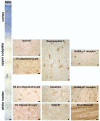Systemic prenatal insults disrupt telencephalon development: implications for potential interventions
- PMID: 16061421
- PMCID: PMC1762129
- DOI: 10.1016/j.yebeh.2005.06.005
Systemic prenatal insults disrupt telencephalon development: implications for potential interventions
Abstract
Infants born prematurely are prone to chronic neurologic deficits including cerebral palsy, epilepsy, cognitive delay, behavioral problems, and neurosensory impairments. In affected children, imaging and neuropathological findings demonstrate significant damage to white matter. The extent of cortical damage has been less obvious. Advances in the understanding of telencephalon development provide insights into how systemic intrauterine insults affect the developing white matter, subplate, and cortex, and lead to multiple neurologic impairments. In addition to white matter oligodendrocytes and axons, other elements at risk for perinatal brain injury include subplate neurons, GABAergic neurons migrating through white matter and subplate, and afferents of maturing neurotransmitter systems. Common insults including hypoxia-ischemia and infection often affect the developing brain differently than the mature brain, and insults precipitate a cascade of damage to multiple neural lineages. Insights from development can identify potential targets for therapies to repair the damaged neonatal brain before it has matured.
Figures


Similar articles
-
Neonatal loss of gamma-aminobutyric acid pathway expression after human perinatal brain injury.J Neurosurg. 2006 Jun;104(6 Suppl):396-408. doi: 10.3171/ped.2006.104.6.396. J Neurosurg. 2006. PMID: 16776375 Free PMC article.
-
Developmental history of the subplate zone, subplate neurons and interstitial white matter neurons: relevance for schizophrenia.Int J Dev Neurosci. 2011 May;29(3):193-205. doi: 10.1016/j.ijdevneu.2010.09.005. Epub 2010 Sep 29. Int J Dev Neurosci. 2011. PMID: 20883772 Review.
-
Populations of subplate and interstitial neurons in fetal and adult human telencephalon.J Anat. 2010 Oct;217(4):381-99. doi: 10.1111/j.1469-7580.2010.01284.x. J Anat. 2010. PMID: 20979586 Free PMC article. Review.
-
Transient cells of the developing mammalian telencephalon are peptide-immunoreactive neurons.Nature. 1987 Feb 12-18;325(6105):617-20. doi: 10.1038/325617a0. Nature. 1987. PMID: 3543691
-
Impact of the use of antenatal corticosteroids on mortality, cerebral lesions and 5-year neurodevelopmental outcomes of very preterm infants: the EPIPAGE cohort study.BJOG. 2008 Jan;115(2):275-82. doi: 10.1111/j.1471-0528.2007.01566.x. BJOG. 2008. PMID: 18081606
Cited by
-
Protein kinase C-dependent growth-associated protein 43 phosphorylation regulates gephyrin aggregation at developing GABAergic synapses.Mol Cell Biol. 2015 May;35(10):1712-26. doi: 10.1128/MCB.01332-14. Epub 2015 Mar 9. Mol Cell Biol. 2015. PMID: 25755278 Free PMC article.
-
Maternal infection and white matter toxicity.Neurotoxicology. 2006 Sep;27(5):658-70. doi: 10.1016/j.neuro.2006.05.004. Epub 2006 May 17. Neurotoxicology. 2006. PMID: 16787664 Free PMC article. Review.
-
Neonatal loss of gamma-aminobutyric acid pathway expression after human perinatal brain injury.J Neurosurg. 2006 Jun;104(6 Suppl):396-408. doi: 10.3171/ped.2006.104.6.396. J Neurosurg. 2006. PMID: 16776375 Free PMC article.
-
Postnatal Erythropoietin Mitigates Impaired Cerebral Cortical Development Following Subplate Loss from Prenatal Hypoxia-Ischemia.Cereb Cortex. 2015 Sep;25(9):2683-95. doi: 10.1093/cercor/bhu066. Epub 2014 Apr 9. Cereb Cortex. 2015. PMID: 24722771 Free PMC article.
-
Subplate neurons: crucial regulators of cortical development and plasticity.Front Neuroanat. 2009 Aug 20;3:16. doi: 10.3389/neuro.05.016.2009. eCollection 2009. Front Neuroanat. 2009. PMID: 19738926 Free PMC article.
References
-
- Martin J, Kochanek K, Strobino D, Guyer B, MacDorman M. Annual summary of vital statistics - 2003. Pediatrics. 2005;115(3):619–634. - PubMed
-
- Petrou S. The economic consequences of preterm birth during the first 10 years of life. BJOG. 2005;112(S1):10–15. - PubMed
-
- D'Angio C, Sinkin R, TP S, Landfish N, Merzbach J, Ryan R, et al. Longitudinal 15-year follow-up of children born at less than 29 weeks gestation after introduction of surfactant therapy into a region: Neurologic, cognitive, and educational outcomes. Pediatrics. 2002;110(6):1094–1102. - PubMed
-
- Vohr B, Wright L, Dusick A, Mele L, Verter J, Steichen J, et al. Neurodevelopmental and functional outcomes of extremely low birth weight infants in the National Institute of Child Health and Human Developmental Research Network, 1993-1994. Pediatrics. 2000;105(6):1216–1226. - PubMed
Publication types
MeSH terms
Grants and funding
LinkOut - more resources
Full Text Sources
Medical

